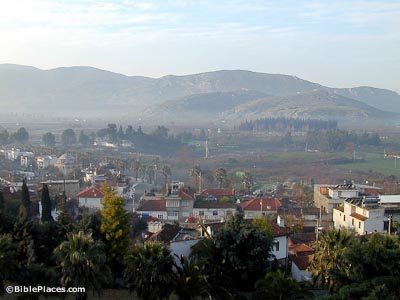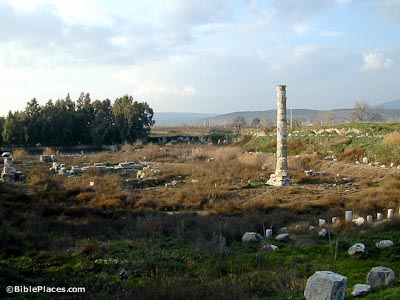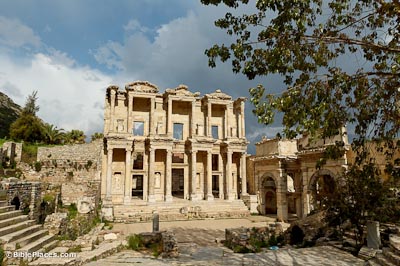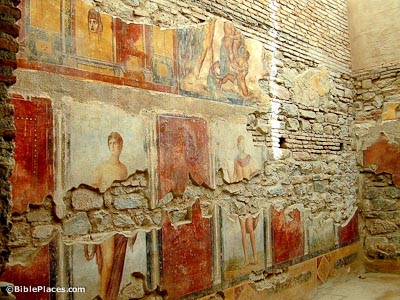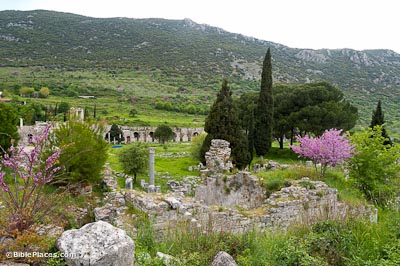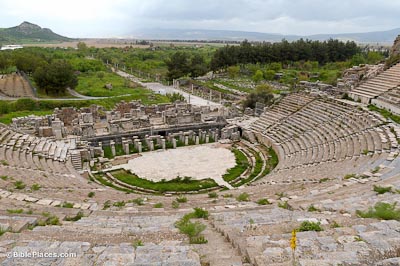Ephesus
Ephesus
In the ancient world, Ephesus was a center of travel and commerce. Situated on the Aegean Sea at the mouth of the Cayster River, the city was one of the greatest seaports of the ancient world.
Three major roads led from the seaport: one road went east towards Babylon via Laodicea, another to the north via Smyrna, and a third south to the Meander Valley.
Temple of Artemis
Considered one of the seven wonders of the ancient world, Ephesus’ Temple of Artemis was dedicated to the goddess of the hunt. Only the foundation and one column remain of this temple which once measured 425 feet (130 m) long, 220 feet (67 m) wide, and 60 feet (18 m) high.
Paul’s successful ministry in this city was considered a threat to this very temple (Acts 19:27).
Library of Celsus
Originally built in AD 115–125, this restored facade is a highlight of the ruins today. This style is believed to be the standard architectural form for Roman libraries. The interior measures 70 by 80 feet (21 x 24 m) and held approximately 15,000 scrolls.
This library was dedicated to Celsus, the proconsul of Asia, and his sarcophagus was located under the apse.
Terrace Houses
From the time of Augustus, these dwellings of wealthy Ephesians were decorated with beautiful frescoes and mosaics. The houses had luxurious bedrooms, bathrooms, triclinium, and kitchens.
Built against the mountain south of Ephesus, the roof of one house forms the terrace for the house above it. These houses were inhabited until the 7th century AD.
Commercial Agora
This market area is known as the “Square Agora” because of its dimensions: 360 feet (110 m) on each side. It arose in the Hellenistic period and was surrounded on all sides by arched shops about 40 feet (12 m) deep. It is located next to the harbor and was the city’s main commercial center. It is quite possible that Paul worked here with Priscilla and Aquila in their tent-making business.
Theater
Originally holding 25,000 people, this theater was built in the Hellenistic period and was renovated by several Roman emperors. Designed for theatrical performances, later alterations allowed gladiatorial contests to be held here.
When Paul was accused of hurting the Artemis and her temple, the mob gathered together in this theater (Acts 19:23-41).
Download all of our Western Turkey photos!
$34.00 $49.99 FREE SHIPPING
Related Websites
See also Colossae, Miletus, Pergamum, and Sardis.
Ephesus (World History Encyclopedia) A nice history of the famed site.
Ephesus (Turizm.net) Describes the history and legends associated with Ephesus, accompanied by a few small pictures.
Ephesus (The Catholic Encyclopedia) A lengthy article detailing the history of the city from its founding to present day. The beginning of Christianity in Ephesus is summarized, highlighting the New Testament period.
Ephesus History (official site) The whole website is informative, but this page in particular gives good background information.
Apostle Paul in Ephesus (ToursAroundTurkey.com) This well-illustrated page is a helpful overview of Paul’s time in the city. The website offers many other brief, informative articles about points of interest in and around Ephesus. The page on the synagogue in Ephesus is also worth a look as is their descriptions and photos of the grotto of the apostle Paul.
Biblical Riot at Ephesus: The Archaeological Context (Bible History Daily) This article gives archaeological perspective on the well-known event from Acts 19.
The Temple of Artemis (Museum of Unnatural Mystery) Traces the historical development of the Temple of Artemis, including the discovery of its remains (against all odds) in the 1800s.
Destroying a Temple: The Burning of the Ephesian Temple of Artemis by Herostratus (Mark Wilson, Bible History Daily) This brief article tells about the 356 BC destruction of the famous temple, which was rebuilt by the time Paul visited. It specifically considers this in light of 1 Corinthians 3:17. An insightful and interesting read!
Ephesus – Redeeming the Time You Have Now (Wayne Stiles) This brief devotional-style article considers how Paul spent his time in Ephesus….and some of the implications for how we should spend ours.
Ephesus, Turkey (Sacred Destinations) Concise, accurate description of the site and its history. Includes links to other sites.
Ancient Ephesus City (Ephesus Breeze) History and description of the various attractions in Ephesus by a local tour agency that offers day trips at a reasonable cost.
Turkey and Seven Churches of Revelation Photo Album (ArcImaging, Rex Geissler) Many large photographs from a tour. Go to “E” section for Ephesus.
